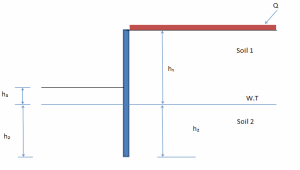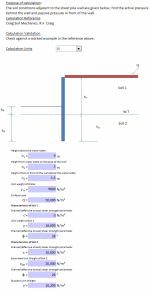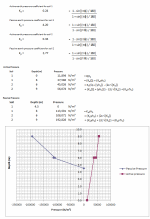Analysis of a sheet pilewall.xls

Description
Purpose of calculation: The soil conditions adjacent to the sheet pile wall are given below, find the active pressure behind the wall and passive pressure in front of the wall.
Calculation Reference: Craig Soil Mechanics. R.F. Craig
Calculation Validation: Check against a worked example in the reference above.
Calculation Parameters
Height above the water table
Height from water table to the base of the wall
Height of soil in front of the wall above the water table
Unit weight of Water
Surface Load
Characteristics of Soil 1
Drained (effective stress) shear strength parameter
Unit weight of Soil 1
Drained (effective stress) shear strength parameter
Characteristics of Soil 2
Drained (effective stress) shear strength parameter
Saturated Unit Weight of Soil 2
Drained (effective stress) shear strength parameter
Buoyant Unit Weight
Active earth pressure coefficient for soil 1
Passive earth pressure coefficient for soil 1
Active earth pressure coefficient for soil 2
Passive earth pressure coefficient for soil 2
Calculation Reference
Geotechnics
Soil Mechanics
Craig's Soil Mechanics
The analysis of a sheet pile wall following Craig's Soil Mechanics involves the application of soil mechanics principles to determine the lateral earth pressure on the wall and the required embedment depth of the sheet piles. The analysis is based on the following assumptions:
- The soil is homogeneous and isotropic.
- The soil is in a state of lateral pressure at rest.
- The wall is rigid and does not deform.
The analysis can be performed in the following steps:
- Determine the soil properties, such as the soil type, unit weight, angle of internal friction, and cohesion.
- Calculate the active and passive earth pressures acting on the wall using the Rankine or Coulomb's theory. The active earth pressure is the pressure exerted by the soil on the wall when the wall moves away from the soil, while the passive earth pressure is the pressure exerted by the soil on the wall when the wall moves towards the soil.
- Determine the net lateral earth pressure on the wall by subtracting the passive pressure from the active pressure.
- Calculate the required embedment depth of the sheet piles using the Rankine or Coulomb's theory. The embedment depth is the depth to which the sheet piles need to be driven into the soil to resist the lateral earth pressure and prevent the wall from overturning or sliding.
The analysis can be further refined by considering other factors, such as the presence of groundwater, the effect of surcharge loads, the effect of soil stratification, and the effect of soil consolidation. The analysis can also be performed using computer software or spreadsheet programs, which can provide more accurate and efficient results.
Overall, the analysis of a sheet pile wall following Craig's Soil Mechanics provides a rigorous and systematic approach to design and construct a sheet pile wall that can resist the lateral earth pressure and ensure the stability and safety of the structure.
Calculation Preview
Full download access to any calculation is available to users with a paid or awarded subscription (XLC Pro).
Subscriptions are free to contributors to the site, alternatively they can be purchased.
Click here for information on subscriptions.


